Haptic Systems: Trends and Lessons Learned for Haptics in Spacesuits
Abstract
1. Introduction
2. Literature Review
3. Current Space Mission Challenges and Attempts to Address Them
3.1. Microgravity and Fall Incidents
3.2. Sensory Deprivation
3.3. Ultraviolet Rays
3.4. Cosmic Rays
3.5. Musculoskeletal Injuries
3.6. Extreme Temperatures
3.7. Lunar/Martian Dust
4. Methodology
4.1. Research Questions
- RQ1: What are the problems that the haptic systems attempted to solve?
- RQ2: What technologies have been used and in what contexts?
- RQ3: What are the existing approaches to haptic systems?
- RQ4: What are the limitations of the existing haptic systems?
- RQ5: What evidence exists to support the validity of haptic systems?
4.2. Research Process
4.3. Inclusion Criteria
- IC1: The included haptic system research must have been published between January 2012 and December 2022.
- IC2: The haptic system must be a wearable haptic for the fingers, hands, or feet.
- IC3: The haptic system must allow users to manipulate objects virtually while receiving haptic feedback.
- IC4: The haptic system must have an application in space exploration, healthcare, gaming, or education.
4.4. Academic Search Database
4.5. Technical and Educational Reports, Articles, and Websites
4.6. Data Analysis
5. Results
5.1. What Are the Problems That the Haptic Systems Attempted to Solve?
5.2. What Haptic Technologies Have Been Used and in What Contexts?
| Haptic Type | Actuator Type | Examples |
|---|---|---|
| Kinesthetics | Mechanical | Shoes [63] |
| Kinesthetics/Tactile | Electromechanical (EM) | Glove [10] |
| Tactile | Vibrotactile | Shoes [11], insole [53], insole [54], insole [55], insole [56], glove [68], glove [69], insole [75], touchscreen [76], smartwatch [84] |
| Tactile | Magnetorheological (MR) fluid | shoes [64], insole [65] |
| Tactile | Microfluidic actuators | Glove [60] |
| Tactile An electrotactile array | N/A | An electrotactile array on the tongue [85] |
| Electrical Muscle Stimulation (EMS), Transcutaneous Electrical Nerve Stimulation (TENS) | N/A | Suit [83] |
5.3. What Are the Approaches to the Haptic Solutions?
5.4. What Are the Reported Limitations of Existing Haptic Systems?
5.5. What Evidence Exists to Support the Validity of Haptic Systems?
6. Discussion and Implications for Haptics in Space
6.1. Discussion
6.2. Implications for Haptics in Space
6.2.1. Haptic Systems Key Metrics of Importance
6.2.2. Safer Walking on Mars/Moon
6.2.3. How Can Spacesuits/Haptic Solutions Reduce Cognitive Load/Sensory Deprivation/Low Pressure/High-Pitch Sound?
6.2.4. How Can Haptic Space Footwear Be Evaluated for Safety and Accuracy?
6.2.5. What Haptic Technology Is Useful for Space Exploration?
- Haptic suit:
- 2.
- Rover robot:
- 3.
- Haptic glove:
- 4.
- Exoskeleton Controller:
6.3. Study Limitations
7. Conclusions
Author Contributions
Funding
Data Availability Statement
Conflicts of Interest
Appendix A
| ID | Haptic System Author | Type | Reference |
|---|---|---|---|
| A1 | Wang and Minor, 2018 | Academic | [63] |
| A2 | Seah et al., 2015 | Academic | [10] |
| A3 | Gibson et al., 2018 | Academic | [11] |
| A4 | de Fazio et al., 2021 | Academic | [52] |
| A5 | Cesini et al., 2020 | Academic | [54] |
| A6 | Shull and Damian, 2015 | Academic | [85] |
| A7 | Shen et al., 2018 | Academic | [27] |
| A8 | Yang et al., 2020 | Academic | [64] |
| A9 | Zanotto et al., 2014 | Academic | [53] |
| A10 | Sie et al., 2018 | Academic | [55] |
| A11 | Seim et al., 2018 | Academic | [84] |
| A12 | Otis et al., 2016 | Academic | [56] |
| A13 | Berengueres et al., 2014 | Academic | [75] |
| A14 | Hinchet et al., 2018 | Academic | [59] |
| A15 | İşleyen et al., 2019 | Academic | [86] |
| A16 | Heo et al., 2020 | Academic | [65] |
| A17 | Bakke and Sue, 2019 | Academic | [2] |
| A18 | Taclim, 2023 | Commercial | [66] |
| A19 | Goode, 2021 | Commercial | [61] |
| A20 | Droplabs, 2021 | Commercial | [72] |
| A21 | Hi5, 2023 | Commercial | [62] |
| A22 | Ti.com, 2023 | Commercial | [76] |
| A23 | Teslasuit, 2023 | Commercial | [83] |
| A24 | HaptX, 2023 | Commercial | [60] |
| A25 | Lechal, 2023 | Commercial | [57] |
| A26 | Vibrasole, 2023 | Commercial | [58] |
| A27 | Haptic Workstation, 2023 | Commercial | [71] |
| A28 | Sensorial XR, 2023 | Commercial | [68] |
| A29 | Tacticalhaptics, 2023 | Commercial | [69] |
| A30 | Manus, 2023 | Commercial | [70] |
| A31 | Avatar VR, 2023 | Commercial | [67] |
References
- Biswas, S.; Visell, Y. Emerging material technologies for haptics. Adv. Mater. Technol. 2019, 4, 1900042. [Google Scholar] [CrossRef]
- Bakke, T.H.; Fairburn, S. Considering Haptic Feedback Systems for A Livable Space Suit. Des. J. 2019, 22, 1101–1116. [Google Scholar] [CrossRef]
- Lindeman, R.W.; Page, R.; Yanagida, Y.; Sibert, J.L. Towards Full-Body Haptic Feedback: The Design and Deployment of a Spatialized Vibrotactile Feedback System. In Proceedings of the ACM Symposium on Virtual Reality Software and Technology, New York, NY, USA, 10–12 November 2004. [Google Scholar]
- Novich, S.D.; Eagleman, D.M. Using space and time to encode vibrotactile information: Toward an estimate of the skin’s achievable throughput. Exp. Brain Res. Vol. 2015, 233, 2777–2788. [Google Scholar] [CrossRef]
- Malone, P.S.A.E.S.P.; Auer, E.T.; Klein, R.; Bernstein, L.E.; Riesenhuber, M. Neural basis of learning to perceive speech through touch using an acoustic-to-vibrotactile speech sensory substitution. bioRxiv 2021. [Google Scholar] [CrossRef]
- Payra, S.; Wicaksono, I.; Cherston, J.; Honnet, C.; Sumini, V.; Paradiso, J.A. Feeling Through Spacesuits: Application of Space-Resilient E-Textiles to Enable Haptic Feedback on Pressurized Extravehicular Suits. In Proceedings of the IEEE Aerospace Conference, Big Sky, MT, USA, 6–13 March 2021. [Google Scholar]
- Thuro, A.; Stirling, L. Characterization of the Apollo Astronaut Lunar Extravehicular Activity Falls and Near-Falls. In Proceedings of the 2021 IEEE Aerospace Conference, Big Sky, MT, USA, 6–13 March 2021. [Google Scholar]
- Noel, J.-P.; Park, H.-D.; Pasqualini, I.; Lissek, H.; Wallace, M.; Blanke, O.; Serino, A. Audio-visual sensory deprivation degrades visuo-tactile peripersonal space. Conscious. Cogn. 2018, 61, 61–75. [Google Scholar] [CrossRef] [PubMed]
- Kubis, J.F.; Elrod, J.T.; Rusnak, R.; Barnes, J.E. Apollo 15 Time and Motion Study; NASA: New York, NY, USA, 1972.
- Seah, S.A.; Obrist, M.; Roudaut, A.; Subramanian, S. Need for touch in human space exploration: Towards the design of a morphing haptic glove–ExoSkin. In Proceedings of the Conference on Human-Computer Interaction, Bamberg, Germany, 14–18 September 2015. [Google Scholar]
- Gibson, A.; Webb, A.; Stirling, L. Evaluation of a visual–tactile multimodal display for surface obstacle avoidance during walking. IEEE Trans. Hum.-Mach. Syst. 2018, 48, 604–613. [Google Scholar] [CrossRef]
- Yang, T.-H.; Kim, J.R.; Jin, H.; Gil, H.; Koo, J.-H.; Kim, H.J. Recent advances and opportunities of active materials for haptic technologies in virtual and augmented reality. Adv. Funct. Mater. 2021, 31, 2008831. [Google Scholar] [CrossRef]
- Pacchierotti, C.; Sinclair, S.; Solazzi, M.; Frisoli, A.; Hayward, V.; Prattichizzo, D. Wearable Haptic Systems for the Fingertip and the Hand: Taxonomy, Review, and Perspectives. IEEE Trans. Haptics 2017, 10, 580–600. [Google Scholar] [CrossRef]
- Giri, G.S.; Maddahi, Y.; Zareinia, K. An application-based review of haptics technology. Robotics 2021, 10, 29. [Google Scholar] [CrossRef]
- Hannaford, B.; Okamura, A.M. Haptics. In Springer Handbook of Robotics; Springer: Cham, Switzerland, 2016; pp. 1063–1084. [Google Scholar]
- Basdogan, C.; Giraud, F.; Levesque, V.; Choi, S. A review of surface haptics: Enabling tactile effects on touch surfaces. IEEE Trans. Haptics 2020, 13, 450–470. [Google Scholar] [CrossRef]
- Culbertson, H.; Schorr, S.B.; Okamura, A.M. Haptics: The present and future of artificial touch sensation. Annu. Rev. Control Robot. Auton. Syst. 2018, 1, 85–409. [Google Scholar] [CrossRef]
- Eid, M.A.; Osman, H.A. Affective Haptics: Current Research and Future Directions. IEEE Access 2015, 4, 26–40. [Google Scholar] [CrossRef]
- Weber, B.; Riecke, C.; Stulp, F. Sensorimotor impairment and haptic support in microgravity. Exp. Brain Res. 2021, 239, 967–981. [Google Scholar] [CrossRef]
- Brown, J.W. Crew height measurement. Apollo-Soyuz Test Prokect Med. Rep. 1977, 411, 119–121. [Google Scholar]
- Churchill, E.; Laubach, L.L.; Tebbetts, J.T.M.A.I. Anthropometry for designers. In Anthropometric Source Book; NASA: Houston, TX, USA, 1978; Volume 1. [Google Scholar]
- Thornton, W.E.; Hoffler, G.W.; Rummel, J.A. Anthropometric changes and fluid shifts. In Biomedical Results from Skylab; NASA Special Publication: Houston, TX, USA, 1977; Volume 377, pp. 330–338. [Google Scholar]
- Kim, K.H.; Young, K.; Benson, E.; Jarvis, S.; Vu, L.; Hernandez, Y.; Rajulu, S. Human modeling tools for spacesuit and hardware design and assessment. In DHM and Posturography; Elsevier: Amsterdam, The Netherlands, 2019; pp. 613–625. [Google Scholar]
- Belobrajdic, B.; Melone, K.; Diaz-Artiles, A. Planetary extravehicular activity (EVA) risk mitigation strategies for long-duration space missions. Npj Microgravity 2021, 7, 16. [Google Scholar] [CrossRef] [PubMed]
- Rajulu, S. Human factors and safety in EVA. In Space Safety and Human Performance; Elsevier: Amsterdam, The Netherlands, 2018; pp. 469–500. [Google Scholar]
- McCormack, C.; Phillips-Hungerford, T. The Requirement for Microgravity Specific Footwear and its Impact on Space Architecture. In Proceedings of the 68th International Astronautical Congress, Adelaide, Australia, 25–29 September 2017. [Google Scholar]
- Shen, Y.-Y.; Boppana, A.; Arquilla, K.; Anderson, A.P. Wearable sensor suit system for quantifying human-spacesuit interactions. In Proceedings of the 2018 IEEE Aerospace Conference, Big Sky, MT, USA, 3–10 March 2018. [Google Scholar]
- Hagengruber, A.; Leidner, D.; Vogel, J. EDAN: EMG-controlled daily assistant. In Proceedings of the Companion of the 2017 ACM/IEEE International Conference on Human-Robot Interaction, Vienna, Austria, 6–9 March 2017. [Google Scholar]
- Ellis, E.G. These Boots Keep Astronauts From Tripping over Their Own Feet. WIRED, 10 February 2017. Available online: https://www.wired.com/2017/02/boots-keep-astronauts-tripping-feet/ (accessed on 13 January 2023).
- Diftler, M.A.A.I.C.A.B.L.; Rogers, J.; Davis, D.; Linn, D.; Laske, E.; Ensley, K.; Lee, J. RoboGlove—A Grasp Assist Device for Earth and Space. In Proceedings of the International Conference on Environmental Systems, Bellevue, WA, USA, 12 July 2015. [Google Scholar]
- Richardson, D.; Stevens, J. Thermal Conductance of Space Suit Insulations, Thermal Micrometeroid Garments, and Other Insulations; Johnson Space Center: Houston, TX, USA, 1976. [Google Scholar]
- Larson, K.; Fries, M. Ultraviolet Testing of Space Suit Materials for Mars. In Proceedings of the International Conference on Environmental Systems, Charleston, SC, USA, 16–20 July 2017. [Google Scholar]
- Hellweg, C.E.; Baumstark-Khan, C. Getting ready for the manned mission to Mars: The astronauts’ risk from space radiation. Naturwissenschaften 2007, 94, 517–526. [Google Scholar] [CrossRef]
- Bishawi, M.; Lee, F.H.; Abraham, D.M.; Glass, C.; Blocker, S.J.; Cox, D.J.; Brown, Z.D.; Rockman, H.A.; Mao, L.; Slaba, T.C.; et al. Late onset cardiovascular dysfunction in adult mice resulting from galactic cosmic ray exposure. iScience 2022, 25, 104086. [Google Scholar] [CrossRef]
- Simonsen, L.C.; Slaba, T.C.; Guida, P.; Rusek, A. NASA’s first ground-based Galactic Cosmic Ray Simulator: Enabling a new era in space radiobiology research. PLoS Biol. 2020, 18, e3000669. [Google Scholar] [CrossRef]
- Diaz, A.; Newman, D. Musculoskeletal human-spacesuit interaction model. In Proceedings of the 2014 IEEE Aerospace Conference, Big Sky, MT, USA, 1–8 March 2014. [Google Scholar]
- Swan, L.; Otani, H.; Loubert, P.V. Reducing postural sway by manipulating the difficulty levels of a cognitive task and a balance task. Gait Posture 2007, 26, 470–474. [Google Scholar] [CrossRef]
- Carr, C.E.; Newman, D.J. Characterization of a lower-body exoskeleton for simulation of space-suited locomotion. Acta Astronaut. 2008, 62, 308–323. [Google Scholar] [CrossRef]
- Boppana, A.; Anderson, A.P. Novel spacesuit boot design developed from dynamic foot shape modeling. Footwear Sci. 2021, 15, S99–S101. [Google Scholar] [CrossRef]
- Dansereau, S.H.; Robinson, S.; Anderson, A.; Carroll, D. Utilization of Biomimicry and Wearable Sensors in Extramuscular Assisted Spacesuit Glove Design. In Proceedings of the ASCEND 2021, Las Vegas, NV, USA, 15–17 November 2021. [Google Scholar]
- Pantaleano, M.J.; Lacey, D.F. Atellite Handling Loads on the Shuttle Extravehicular Mobility Unit (EMU) Spacesuit: An Examination of the Loads Imparted to the Suit as a Result of Handling Massive Objects in EVA. SAE Trans. 1992, 13, 1204–1216. [Google Scholar]
- Strauss, S. Space medicine at the NASA-JSC, neutral buoyancy laboratory. Aviat. Space Environ. Med. 2008, 79, 732–733. [Google Scholar] [PubMed]
- Essinger-Hileman, T.M. Cosmic Background Explorer. NASA Goddard Space Flight Center. Available online: https://lambda.gsfc.nasa.gov/product/cobe/ (accessed on 11 January 2023).
- Dunbar, B. The Moon; NASA: Washington, DC, USA, 2020. Available online: https://www.nasa.gov/moon (accessed on 10 January 2023).
- Christiansen, E.; Lear, D.; Hyde, J. Micro-Meteoroid and Orbital Debris (MMOD) Protection Overview; NASA: Washington, DC, USA, 2018.
- Christoffersen, R.; Lindsay, J.F.; Noble, K.N.; Lawrence, J.A. Lunar Dust Effects on Spacesuit Systems Insights from the Apollo Spacesuits. Nasa. 2009. Available online: https://www.lpi.usra.edu/lunar/strategies/ChristoffersenEtAl_NASA-TP-2009-214786_LunarDustEffectsSpacesuitSystems.pdf (accessed on 18 March 2023).
- Rezende, J.; Moiseev, N.; Souza, D.; Santos, D. Spacesuits: Challenges and research. In Proceedings of the 50th International Conference on Environmental Systems, Lisbon, Portugal, 12–16 July 2020. [Google Scholar]
- Manyapu, K.K.; De Leon, P.; Peltz, L.; Gaier, J.R.; Waters, D. Proof of concept demonstration of novel technologies for lunar spacesuit dust mitigation. Acta Astronaut. 2017, 137, 472–481. [Google Scholar] [CrossRef]
- Manyapu, K.K.; Peltz, L.; Leon, P.D. Safety considerations for SPIcDER: Spacesuit integrated carbon nanotube dust ejection/removal system. J. Space Saf. Eng. 2022, 9, 3–11. [Google Scholar] [CrossRef]
- Tisdale, M.; Dulá, I.; Madrid, L.P.; Verkhovodova, P.; Pénot, J.; Coimbra, K.; Soldner, L.; Gupta, T.; Musuku, R.; Chung, S.-J. Design of a Modular and Orientable Electrodynamic Shield for Lunar Dust Mitigation. In Proceedings of the AIAA SCITECH 2022 Forum, San Diego, CA, USA, 3–7 January 2022. [Google Scholar]
- Kawamoto, H.A.I.H. Magnetic cleaning device for lunar dust adhering to spacesuits. J. Aerosp. Eng. 2012, 25, 139–142. [Google Scholar] [CrossRef]
- de Fazio, R.; Perrone, E.; Velázquez, R.; De Vittorio, M.; Visconti, P. Development of a Self-Powered Piezo-Resistive Smart Insole Equipped with Low-Power BLE Connectivity for Remote Gait Monitoring. Sensors 2021, 21, 4539. [Google Scholar] [CrossRef]
- Zanotto, D.; Turchet, L.; Boggs, E.M.; Agrawal, S.K. SoleSound: Towards a novel portable system for audio-tactile underfoot feedback. In Proceedings of the 5th IEEE RAS/EMBS International Conference on Biomedical Robotics and Biomechatronics, Sao Paulo, Brazil, 12–15 August 2014. [Google Scholar]
- Cesini, I.; Spigler, G.; Prasanna, S.; D’abbraccio, J.; De Luca, D.; Dell’Agnello, F.; Crea, S.; Vitiello, N.; Mazzoni, A.; Oddo, C.M. Assessment of intuitiveness and comfort of wearable haptic feedback strategies for assisting level and stair walking. Electronics 2020, 9, 1676. [Google Scholar] [CrossRef]
- Sie, A.; Boe, D.; Rombokas, E. Design and evaluation of a wearable haptic feedback system for lower limb prostheses during stair descent. In Proceedings of the 2018 7th IEEE International Conference on Biomedical Robotics and Biomechatronics (BioRob), Enschede, The Netherlands, 26–29 August 2018. [Google Scholar]
- Otis, M.J.-D.; Ayena, J.C.; Tremblay, L.E.; Fortin, P.E.; Menelas, B.-A.J. Use of an enactive insole for reducing the risk of falling on different types of soil using vibrotactile cueing for the elderly. PLoS ONE 2016, 11, e0162107. [Google Scholar] [CrossRef]
- Lechal. Available online: https://www.lechal.com/ (accessed on 5 March 2023).
- Amarasiriwardena, N. Vibrasole. Available online: http://niroshan.com/projects/vibrasole (accessed on 5 March 2023).
- Hinchet, R.; Vechev, V.; Shea, H.; Hilliges, O. Dextres: Wearable haptic feedback for grasping in vr via a thin form-factor electrostatic brake. In Proceedings of the 31st Annual ACM Symposium on User Interface Software and Technology, Berlin, Germany, 14–17 October 2018. [Google Scholar]
- HaptX. Available online: https://haptx.com/ (accessed on 5 March 2023).
- Lauren Goode, Facebook Reaches for More Realistic VR with Haptic Gloves. 2021. Available online: https://www.wired.com/story/facebook-haptic-gloves-vr/ (accessed on 5 March 2023).
- Hi5 VR Glove. Available online: https://hi5vrglove.com/ (accessed on 5 March 2023).
- Wang, Y.; Minor, M.A. Design and Evaluation of a Soft Robotic Smart Shoe for Haptic Terrain Rendering. IEEE/ASME Trans. Mechatron. 2018, 23, 2974–2979. [Google Scholar] [CrossRef]
- Yang, T.-H.; Son, H.; Byeon, S.; Gil, H.; Hwang, I.; Jo, G.; Choi, S.; Kim, S.-Y.; Kim, J.R. Magnetorheological Fluid Haptic Shoes for Walking in VR. IEEE Trans. Haptics 2020, 14, 83–94. [Google Scholar] [CrossRef] [PubMed]
- Heo, Y.H.; Byeon, S.; Kim, T.-H.; Yun, I.-H.; Kim, J.R.; Kim, S.-Y. Investigation of a haptic actuator made with magneto-rheological fluids for haptic shoes applications. Actuators 2020, 10, 5. [Google Scholar] [CrossRef]
- Taclim. Available online: https://taclim.cerevo.com/en/ (accessed on 5 March 2023).
- Avatar VR. Available online: https://tracxn.com/d/companies/avatar-vr/__I9dmAbCl882Wb-MVEh7d13AMK-HjMNb93s97SRHOBj4#:~:text=Avatar%20VR%20from%20NeuroDigital%20Technologies,and%205%20on%20the%20palm (accessed on 5 March 2023).
- Sensorial XR. Available online: https://www.linkedin.com/showcase/sensorial-xr/about/ (accessed on 17 March 2023).
- Tacticalhaptics. Available online: https://tacticalhaptics.com/products/ (accessed on 6 March 2023).
- Manus. Available online: https://www.manus-meta.com/products/prime-x-haptic (accessed on 6 March 2023).
- Haptic Workstation. Available online: http://www.cyberglovesystems.com/haptic-workstation (accessed on 6 March 2023).
- Droplabs. Available online: https://droplabs.com/ (accessed on 13 January 2023).
- Wang, D.; Song, M.; Naqash, A.; Zheng, Y.; Xu, W.; Zhang, Y. Toward Whole-Hand Kinesthetic Feedback: A Survey of Force Feedback Gloves. IEEE Trans. Haptics 2019, 12, 189–204. [Google Scholar] [CrossRef] [PubMed]
- Strohmeier, P.; Hornbæk, K. Generating haptic textures with a vibrotactile actuator. In Proceedings of the 2017 CHI Conference on Human Factors in Computing Systems, Denver, CO, USA, 6–11 May 2017. [Google Scholar]
- Berengueres, J.; Fritschi, M.; McClanahan, R. A Smart Pressure-Sensitive Insole that Reminds You to Walk Correctly: An Orthotic-less Treatment for Over Pronation. In Proceedings of the 2014 36th Annual International Conference of the IEEE Engineering in Medicine and Biology Society, Chicago, IL, USA, 26–30 August 2014. [Google Scholar]
- Ti.com. Available online: https://www.ti.com/lit/ml/slyt554a/slyt554a.pdf (accessed on 6 March 2023).
- Patrascu, M.; Gonzalo-Ruiz, J.; Goedbloed, M.; Brongersma, S.H.; Crego-Calama, M. Flexible, electrostatic microfluidic actuators based on thin film fabrication. Sens. Actuators A Phys. 2012, 186, 249–256. [Google Scholar] [CrossRef]
- Oh, J.-S.; Sohn, J.W.; Choi, S.-B. Applications of magnetorheological fluid actuator to multi-DOF systems: State-of-the-art from 2015 to 2021. Actuators 2022, 11, 44. [Google Scholar] [CrossRef]
- Maffiuletti, N.A.; Minetto, M.A.; Farina, D.; Bottinelli, R. Electrical stimulation for neuromuscular testing and training: State-of-the art and unresolved issues. Eur. J. Appl. Physiol. 2011, 111, 2391–2397. [Google Scholar] [CrossRef]
- Lopes, P.; Ion, A.; Baudisch, P. Impacto: Simulating physical impact by combining tactile stimulation with electrical muscle stimulation. In Proceedings of the 28th Annual ACM Symposium on User Interface Software & Technology, Charlotte, NC, USA, 11–15 November 2015. [Google Scholar]
- Pfeiffer, M.; Dünte, T.; Schneegass, S.; Alt, F.; Rohs, M. Cruise Control for Pedestrians: Controlling Walking Direction using Electrical Muscle Stimulation. In Proceedings of the 33rd Annual ACM Conference on Human Factors in Computing Systems, Seoul, Republic of Korea, 18–23 April 2015. [Google Scholar]
- Tamaki, E.; Miyaki, T.; Rekimoto, J. PossessedHand: Techniques for controlling human hands using electrical muscles stimuli. In Proceedings of the SIGCHI Conference on Human Factors in Computing Systems, Vancouver, BC, Canada, 7 May 2011. [Google Scholar]
- Teslasuit. Available online: https://teslasuit.io/products/teslasuit-4/ (accessed on 6 March 2023).
- Seim, C.; Pontes, R.; Kadiveti, S.; Adamjee, Z.; Cochran, A.; Aveni, T.; Presti, P.; Starner, T. Towards Haptic Learning on a Smartwatch. In Proceedings of the 2018 ACM International Symposium on Wearable Computers, New York, NY, USA, 21 November 2018. [Google Scholar]
- Shull, P.B.; Damian, D.D. Haptic wearables as sensory replacement, sensory augmentation and trainer—A review. J. NeuroEng. Rehabil. 2015, 12, 59. [Google Scholar] [CrossRef]
- İşleyen, A.; Vardar, Y.; Basdogan, C. Tactile Roughness Perception of Virtual Gratings by Electrovibration. IEEE Trans. Haptics 2019, 13, 562–570. [Google Scholar] [CrossRef]
- Withana, A.; Groeger, D.; Steimle, J. Tacttoo: A Thin and Feel-Through Tattoo for On-Skin Tactile Output. In Proceedings of the 31st Annual ACM Symposium on User Interface Software and Technology (UIST ’18), New York, NY, USA, 14–17 October 2018. [Google Scholar]
- Elliott, L.R.; Coovert, M.D.; Prewett, M.; Walvord, A.G.; Saboe, K.; Johnson, R. A Review and Meta Analysis of Vibrotactile and Visual Information Displays. In Aberdeen Proving Ground; Army Research Laboratory: Adelphi, MD, USA, 2009. [Google Scholar]
- Yin, J.; Hinchet, R.; Shea, H.; Majidi, C. Wearable soft technologies for haptic sensing and feedback. Adv. Funct. Mater. 2021, 31, 2007428. [Google Scholar] [CrossRef]
- Son, H.; Hwang, I.; Yang, T.-H.; Choi, S.; Kim, S.-Y.; Kim, J.R. RealWalk: Haptic Shoes Using Actuated MR Fluid for Walking in VR. In Proceedings of the 2019 IEEE World Haptics Conference (WHC), Tokyo, Japan, 9–12 July 2019. [Google Scholar]
- Takeuchi, Y. Gilded gait: Reshaping the urban experience with augmented footsteps. In Proceedings of the 23nd Annual ACM Symposium on User Interface Software and Technology, New York, NY, USA, 3–6 October 2010. [Google Scholar]
- Godfroy, M.; Wenzel, E.M. Human dimensions in multimodal wearable virtual simulators for extra vehicular activities. In Proceedings of the NATO Workshop Human Dimensions Embedded Virtual Simul, Orlando, FL, USA, 20–22 October 2009. [Google Scholar]
- Mission to Mars One Step Closer with TESLASUIT. Teslasuit, 20 September 2019. Available online: https://teslasuit.io/blog/mission-to-mars-one-step-closer-with-teslasuit/ (accessed on 13 January 2023).
- Wormnes, K.; Carey, W.; Krueger, T.; Cencetti, L.; Exter, E.D.; Ennis, S.; Ferreira, E.; Fortunato, A.; Gerdes, L.; Hann, L.; et al. ANALOG-1 ISS–The first part of an analogue mission to guide ESA’s robotic moon exploration efforts. Open Astron. 2022, 31, 5–14. [Google Scholar] [CrossRef]
- Haptic Devices. The European Space Agency. Available online: https://www.esa.int/Enabling_Support/Space_Engineering_Technology/Automation_and_Robotics/Haptic_Devices (accessed on 1 March 2023).
- Liu, G.; Geng, X.; Liu, L.; Wang, Y. Haptic based teleoperation with master-slave motion mapping and haptic rendering for space exploration. Chin. J. Aeronaut. 2019, 32, 723–736. [Google Scholar] [CrossRef]
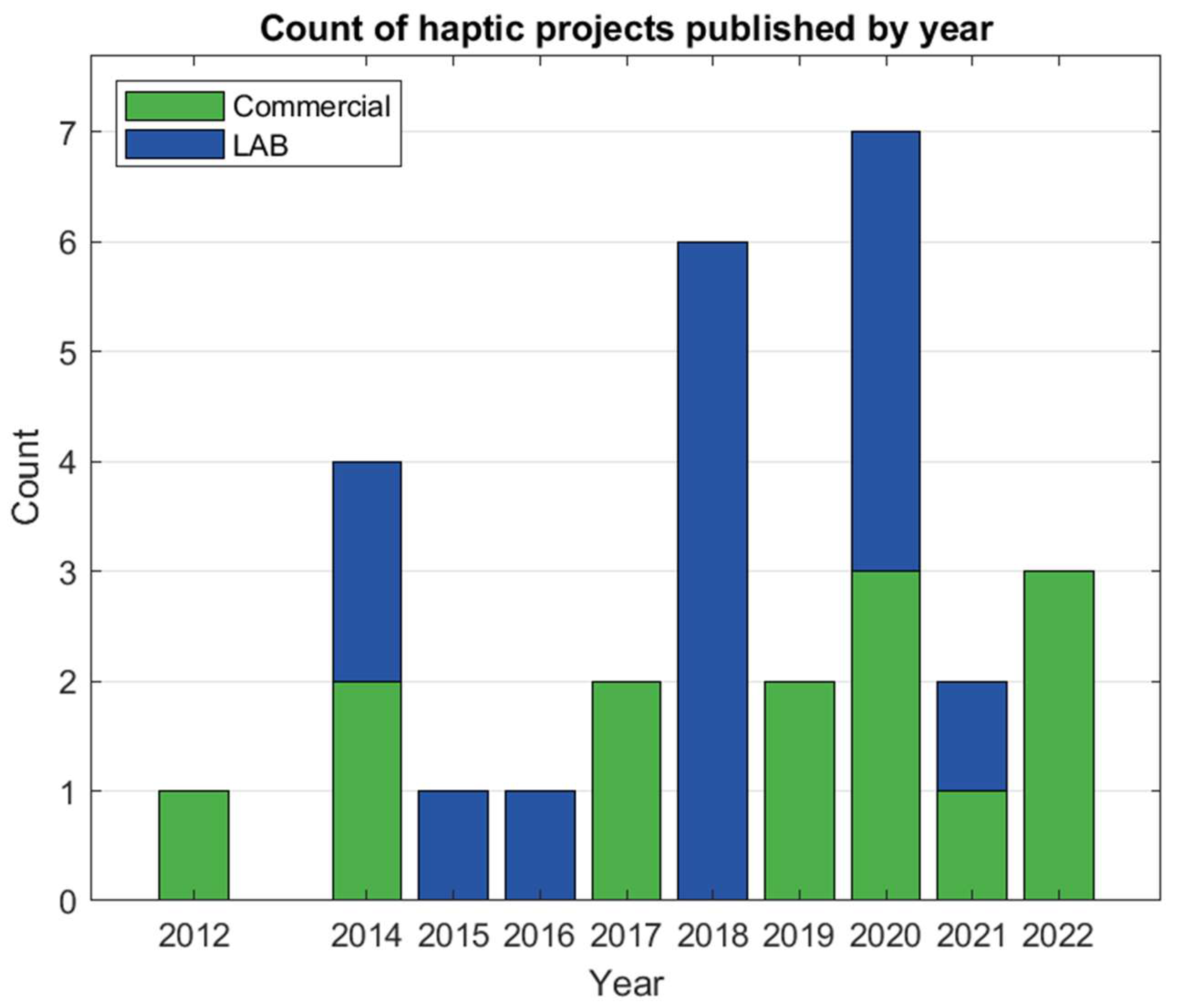
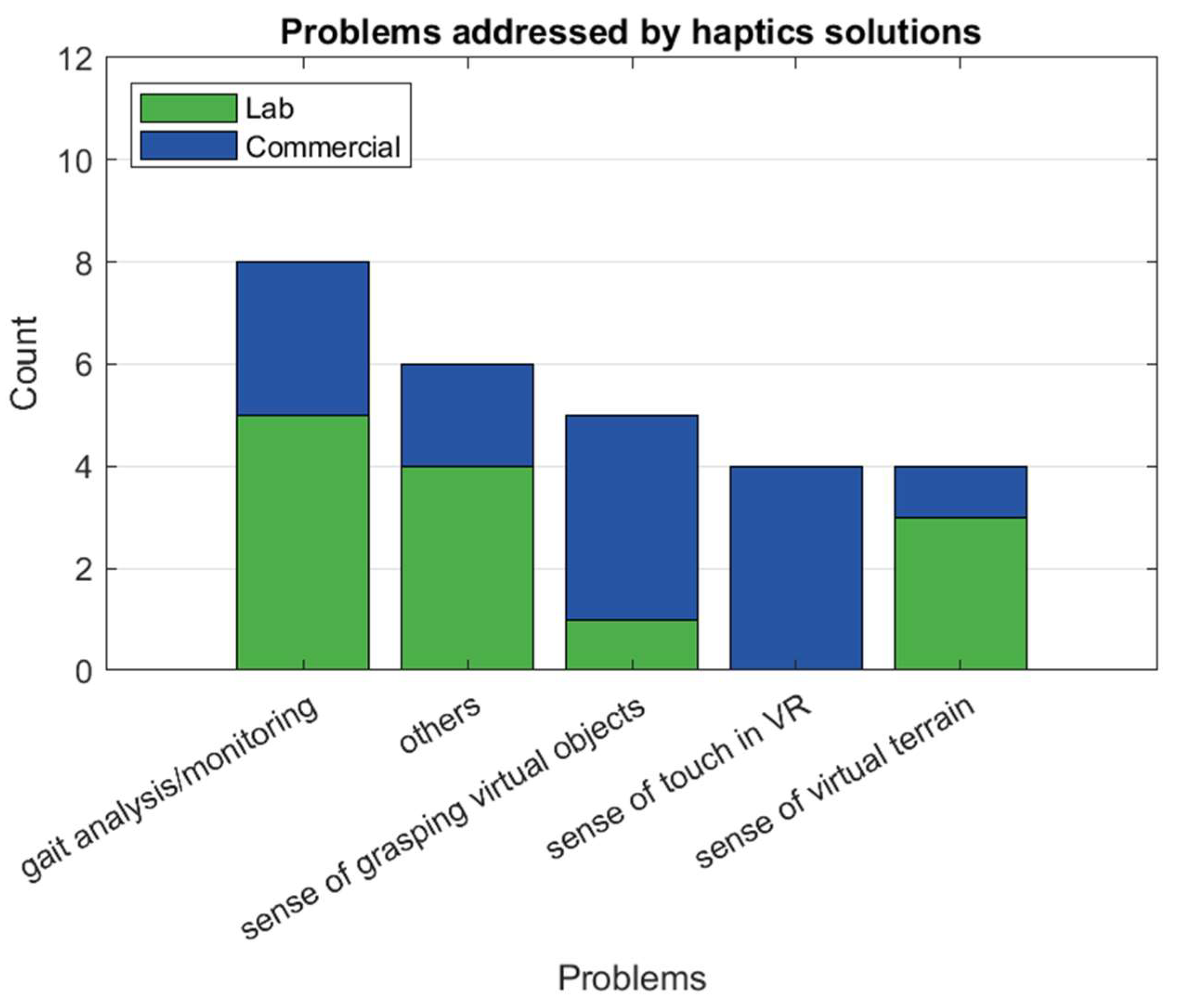
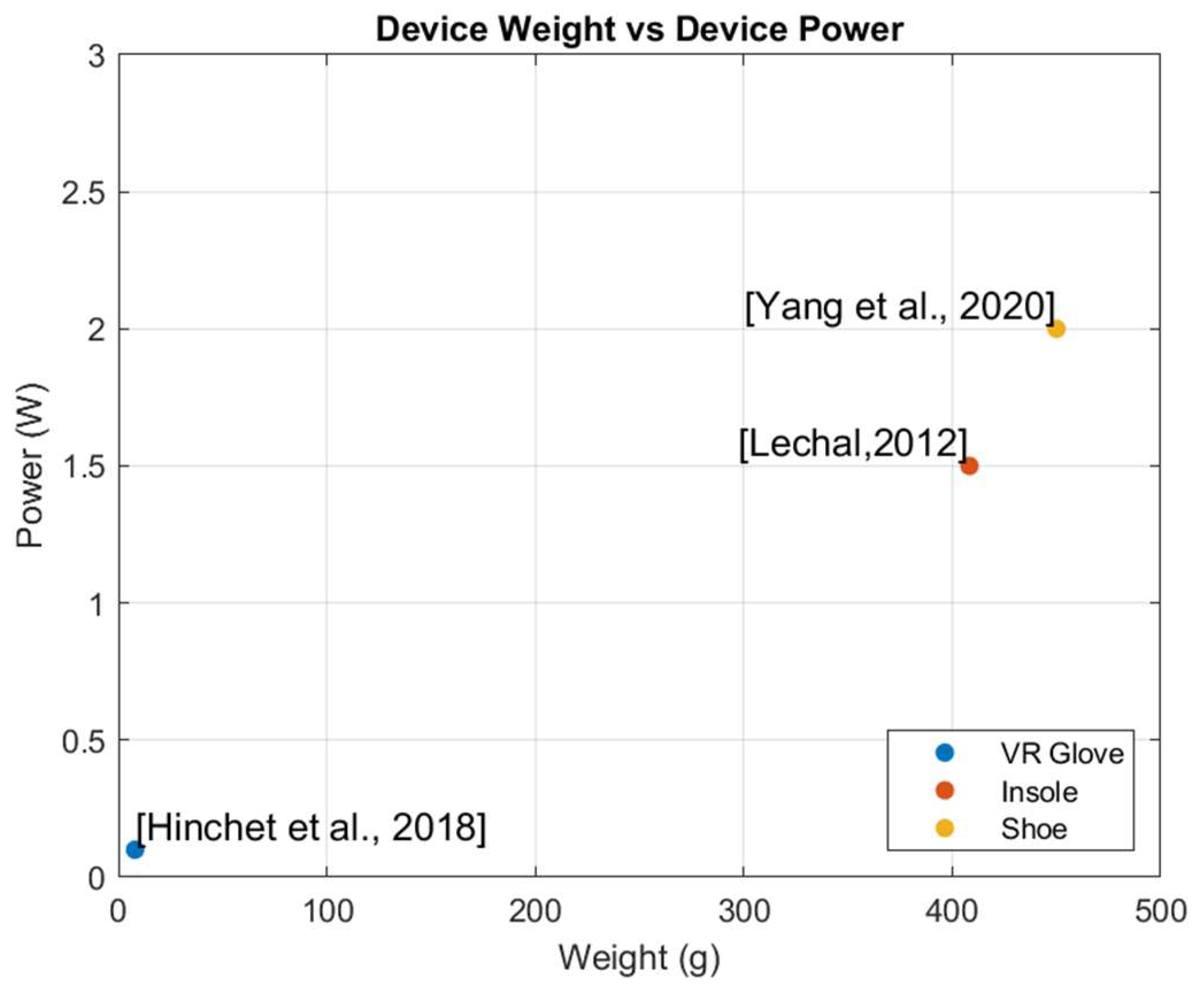
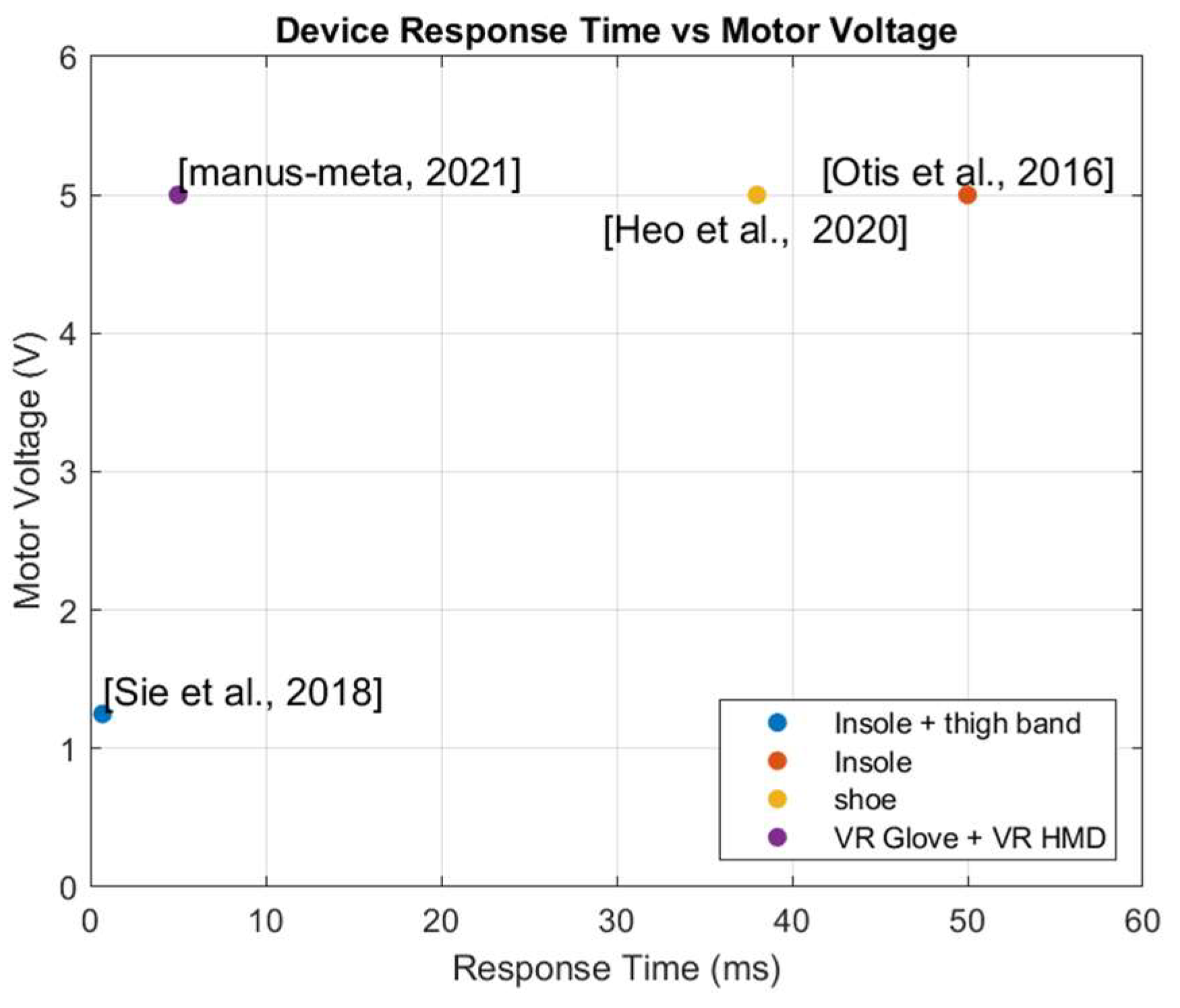

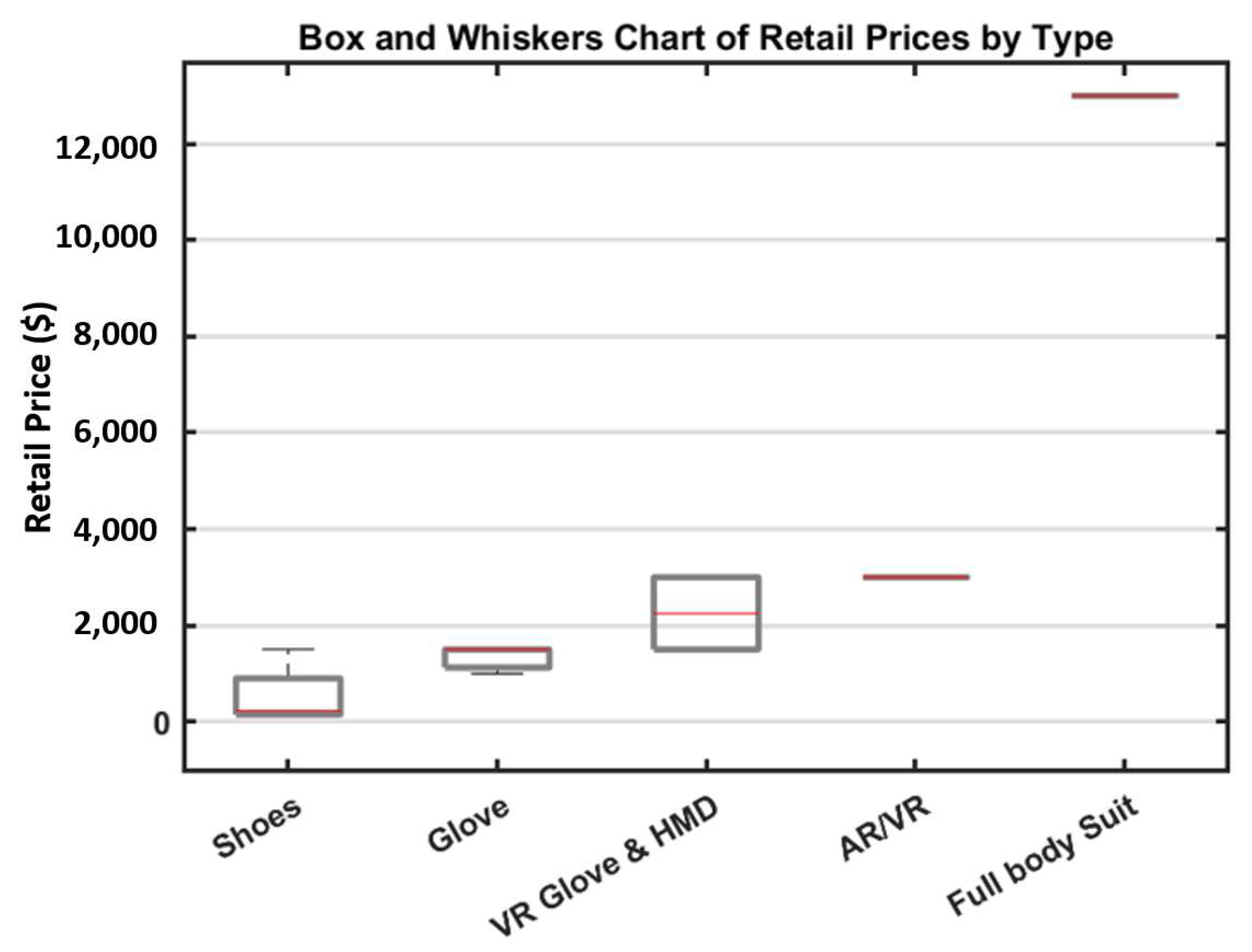
| No. | Haptic Type and Context | Research Focus | Findings | Limitations | Reference |
|---|---|---|---|---|---|
| 1 | General | - Classifying haptics in terms of functionality and construction. - Challenges of adoption. | - Lack of awareness and high cost hinders adoption. | - No discussion of the evaluation of haptic systems. - No discussion of haptic applicability in space. | [14] |
| 2 | Active material-based haptics with an emphasis on immersive applications | - Trends of haptics - Future of immersive application demands. | - Haptics are popular in the industry because of vibrotactile feedback with high spatial resolution, dynamic range, and output intensity. | - No discussion of the evaluation of haptic systems. - No discussion of haptic applicability in space. | [12] |
| 3 | General | - Haptic system design and neurobiology and perception of touch. | - Haptics can be used in mobile communication, navigation, virtual reality, and gaming. - Significance of human touch perception capacity throughout the design process to create usable and effective haptic devices. | - Limited discussion of the evaluation of haptic systems. - No discussion of haptic applicability in space. | [17] |
| 4 | Wearable haptic systems for the fingertips and hands | - Applications of haptics in social interactions, healthcare, virtual reality, remote help, and robotics. | - The wearability of a haptic device is determined by its form factor, weight, impairment, and comfort. - Haptic devices may now be used daily due to their wearability. | - Limited discussion of the evaluation of haptic systems. - No discussion of haptic applicability in space. | [13] |
| 5 | General haptics in psychology, neuroscience, robotics, and virtual reality. | - The application of robotic haptic interfaces in distant or virtual worlds. | - Haptic technology is a rapidly developing field with commercial success in entertainment, medical simulations, and design. | - No discussion of the evaluation of haptic systems. - No discussion of haptic applicability in space. | [15] |
| 6 | Affective haptics | - Recent advances in affective haptics and discusses how touch can alter human emotions. | - Haptic stimulation can enhance media immersion and emotional telepresence. - Haptics is good for communicating valence and arousal, particularly the emotions of happiness, sorrow, rage, and fear. Disgust and surprise have received less attention. | - Limited discussion of the evaluation of haptic systems. - No discussion of haptic applicability in space. | [18] |
| 7 | Tactile interactions of human fingers or hands with surface-haptics displays | - Surface haptics that turn passive surfaces into active ones. - Human perception of tactile stimuli exhibited on active touch surfaces. | - For surface haptic displays to reach the mass market, they must have high transparency, a large tactile interaction area, simultaneous tactile feedback displayed in different directions, simultaneous tactile feedback stimulating different receptors, low power consumption, easy integration, and compact design. | - Limited discussion of the evaluation of haptic systems. - No discussion of haptic applicability in space. | [16] |
| Context of Use | Haptic Type | Example Applications and References |
|---|---|---|
| Indoors | Kinesthetics | Shoes [63,65] |
| Indoors | Tactile | Shoes [64], gloves [59], touchscreen [86] |
| Space | Tactile | Gloves [10], shoes [11] |
| Healthcare | Tactile | Shoe insole [52], shoe insole and vibrotactile belt [53,54], an electrotactile array on the tongue [85], shoe insole and thigh belt [55], shoe insole [56,75] |
| Context of Use | Haptic Type | Example Applications and References |
|---|---|---|
| Indoors | Tactile | Shoes [18,72], gloves [60,61,62,67,70], touch interface [76], gaming equipment [69] |
| Indoors | EMS | Gaming suit [83] |
| Healthcare | Kinesthetics | Shoe insole [57] |
| Healthcare | Tactile | Shoe insole [58] |
| Training | Tactile | Glove exoskeleton [71], glove [68] |
| Evaluation Type | Metric Measured | No. of Participants | Findings | Reference |
|---|---|---|---|---|
| Interviews | EVA experience and reflections on the sense of touch and haptics | 6 | There was a need for varied resolutions of touch in different scenarios. | [10] |
| NASA Task Load | Workload ranking based on mental, physical, temporal, performance, effort, and frustration | 16 | Tactile-only display induced higher mental and temporal workloads compared to having no display. | [11] |
| Experiment (Elo rating) | Intuitiveness and comfort of shoe haptics for stair walking (different simulation strategies) | 6 | The intuitiveness and comfort scores were higher for two strategies: (1) center of pressure (CoP), (2) vertical ground reaction force (vGRF). | [54] |
| Evaluation Study | The perception of how realistic the ground was when wearing haptic shoes (MR fluid-based vs. vibrotactile) | 12 | Participants had a more positive experience with MR fluid-based shoes. | [64] |
| Evaluation Type | Metric Measured | No. of Participants | Findings | Reference |
|---|---|---|---|---|
| Evaluation study | Participants’ identification of the surface details | 8 | The correct identification of surface details was achieved with 93.1% accuracy. | [63] |
| Experiment | 1. Participant’s ability to differentiate distinct vibration positions on the thigh. 2. Participant’s ability to indicate the staircase edge position. | 15 + 13 | 1. The participants correctly distinguished the vibration position with a minimum accuracy of 82%. 2. The participants demonstrated increased accuracy in localizing the step edge when haptic feedback was present. | [55] |
| Evaluation study | Accuracy of learning Morse code using a haptic-based smartwatch | 6 | Lower learning scores for students using the haptic system. | [84] |
| Cycle life tests | The longevity of the haptics in the shoes | N/A | Compositing bladders in the shoes demonstrated more than the targeted 120 k cycles, and catastrophic structural failure did not occur. | [63] |
| Evaluation study | Task completion time, number of collisions | 16 | - Tactical haptics in shoes increased completion time by 49%. - Participants wearing haptic shoes avoided more obstacles | [11] |
| Evaluation Study | Gait pattern when audio-tactile haptic feedback is provided | 3 | Ecological underfoot audio-tactile feedback may significantly alter the natural gait cycle of young healthy subjects. The aggregate material is effective in impacting the user’s gait, especially in the variables’ step length and normalized swing period. | [53] |
| Evaluation Study | Timed Up and Go (TUG) time and risk of falling | 12 | Participants wearing haptic shoe insoles had a higher TUG and fewer risks of falling | [56] |
Disclaimer/Publisher’s Note: The statements, opinions and data contained in all publications are solely those of the individual author(s) and contributor(s) and not of MDPI and/or the editor(s). MDPI and/or the editor(s) disclaim responsibility for any injury to people or property resulting from any ideas, methods, instructions or products referred to in the content. |
© 2023 by the authors. Licensee MDPI, Basel, Switzerland. This article is an open access article distributed under the terms and conditions of the Creative Commons Attribution (CC BY) license (https://creativecommons.org/licenses/by/4.0/).
Share and Cite
Kuhail, M.A.; Berengueres, J.; Taher, F.; Alkuwaiti, M.; Khan, S.Z. Haptic Systems: Trends and Lessons Learned for Haptics in Spacesuits. Electronics 2023, 12, 1888. https://doi.org/10.3390/electronics12081888
Kuhail MA, Berengueres J, Taher F, Alkuwaiti M, Khan SZ. Haptic Systems: Trends and Lessons Learned for Haptics in Spacesuits. Electronics. 2023; 12(8):1888. https://doi.org/10.3390/electronics12081888
Chicago/Turabian StyleKuhail, Mohammad Amin, Jose Berengueres, Fatma Taher, Mariam Alkuwaiti, and Sana Z. Khan. 2023. "Haptic Systems: Trends and Lessons Learned for Haptics in Spacesuits" Electronics 12, no. 8: 1888. https://doi.org/10.3390/electronics12081888
APA StyleKuhail, M. A., Berengueres, J., Taher, F., Alkuwaiti, M., & Khan, S. Z. (2023). Haptic Systems: Trends and Lessons Learned for Haptics in Spacesuits. Electronics, 12(8), 1888. https://doi.org/10.3390/electronics12081888








